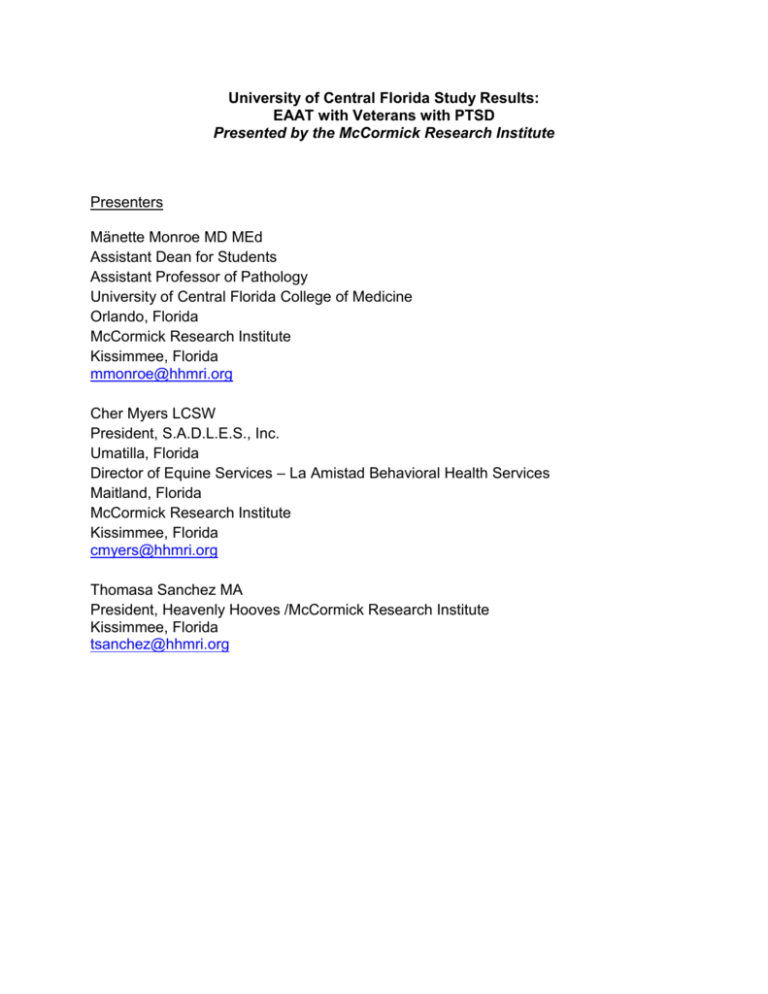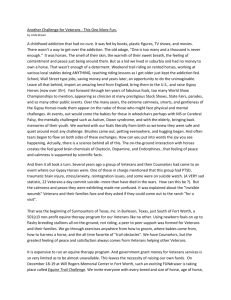University of Central Florida Study Results
advertisement

University of Central Florida Study Results: EAAT with Veterans with PTSD Presented by the McCormick Research Institute Presenters Mänette Monroe MD MEd Assistant Dean for Students Assistant Professor of Pathology University of Central Florida College of Medicine Orlando, Florida McCormick Research Institute Kissimmee, Florida mmonroe@hhmri.org Cher Myers LCSW President, S.A.D.L.E.S., Inc. Umatilla, Florida Director of Equine Services – La Amistad Behavioral Health Services Maitland, Florida McCormick Research Institute Kissimmee, Florida cmyers@hhmri.org Thomasa Sanchez MA President, Heavenly Hooves /McCormick Research Institute Kissimmee, Florida tsanchez@hhmri.org Introduction Thomasa Sanchez MS MA An introduction explaining who we are, where we have come from, where we are now and where we are going. The Research Project Mänette Monroe MD MEd Horses and Veterans Application of equine assisted therapy to disabled American military veterans began in 2006 Pilot program involving the 1st Infantry Battalion, 3rd Infantry Regiment at Fort Myer, Virginia in conjunction with NARHA (PATH< Intl). Six wounded military veterans who had served in Iraq and Afghanistan Four week therapeutic horseback riding program. PATH International Equine Services for Heroes Therapeutic horseback riding for veterans. Now offered by majority of PATH Intl. recognized centers in the United States. While there are many centers offering this treatment modality, there has yet to be the identification of clinical best practices for either the civilian or veteran population. Testimonials of the benefits of equine assisted therapy are abundant, only scant peer reviewed literature exists. Primarily focused on the efficacy of EAAT for the treatment of children with cerebral palsy. Physical act of riding a horse leads to increased core strength and balance. Little published research specifically with veteran population. Other modalities of animal assisted therapy for this population exist, but suffer from the same lack of peer-reviewed investigations Significant differences for equine assisted therapy exist when compared to other types of animal assisted therapy. Horses are prey animals and therefore live in a heightened state of awareness, similar to the daily existence of patents suffering from PTSD. It is postulated that interaction with horses will help veterans better cope with their own feelings of high stress. May be effect of neuro-plasticity The transference of the veterans’ emotions to another living being may be very beneficial in helping this population recover a higher level of daily functioning. UCF COM, Heavenly Hooves, S.A.D.L.E.S. and Osceola County Florida propose to develop an international center for excellence in Equine Assisted Therapy. This center will be located near the Orlando, Florida Medical City campus. The 2nd largest Veterans Administration hospital in the VA system is being built in the Medical City and will begin receiving patients in summer 2014. Research Protocol Does participation in Equine Assisted Therapy lead to improved psychological outcomes for American military veterans with combat related mental injuries? Hypothesis Participation in Equine Assisted Therapy will lead to improved psychological outcomes for American military veterans with combat related mental injuries. Design Study Aims: Measure, utilizing standardized psychological testing, mental health outcomes from equine assisted therapy with American military veterans. Information gathered will be used to identify best practices and provide guidance in EAAT for standardization of care. Study Participants: Participants will be recruited from veterans enrolled in equine assisted therapy sessions at Heavenly Hooves, Inc. in Osceola County, Florida. These veterans are self–identified as having psychological trauma from their wartime experiences. Inclusion Criteria American military veterans, male or female, aged 18 to 75 years who are currently receiving or have received therapeutic riding instruction with Heavenly Hooves, Inc. in Osceola County, Florida. Exclusion Criteria Veterans aged less than 18 years or greater than 75 years who are currently receiving or have received therapeutic riding instruction with Heavenly Hooves, Inc. in Osceola County, Florida. Non-veterans who are currently receiving or have received therapeutic riding instruction with Heavenly Hooves, Inc. in Osceola County, Florida. Participant Evaluation: The participants in the Veterans Research Project were surveyed and examined prior to participation in the equine assisted therapy program for signs of psychological trauma as a part of the program intake process. A Florida licensed clinical social worker, with experience working with the veteran population, and a Florida licensed physician used industry standard instruments for the psychological evaluation. The instrument used is the Becks Depression Inventory II (BDI-II) This protocol is utilized as the standard intake procedure for all participants in the Veterans Research Project veterans’ equine assisted therapy program at Heavenly Hooves, Inc. Research Protocol Continued The equine assisted therapy sessions were conducted by Heavenly Hooves, Inc. at their facility in Kissimmee, FL. Standard therapeutic horseback riding practices as specified by PATH International. Equine assisted therapeutic practices were derived from the principles and practices of Experiential Education, PATH, International, EAGALA, Natural Horsemanship and the SADLES curriculum developed by Cher Myers. Study participants were asked to undergo a post-evaluation at the conclusion of the equine assisted therapy sessions. This evaluation consisted of completion of the same psychological instrument utilized at the pre-evaluation session. A narrative evaluation of the program by the participants was also conducted and digitally recorded utilizing a standardized question format for all participants. Questions utilized: What were your expectations of the Veterans Research Project sessions before you actually began? What was the most unexpected thing to occur to you during these sessions? What has been the most significant change (negative or positive) in your daily life since participating in the sessions? What was your favorite activity during the sessions? What was your least favorite activity during the sessions? How would you change the sessions to make them better? Data Analysis: The results of the BDI-II were analyzed for significance using the Wilcox Signed Ranks test. The narrative data from the interviews was analyzed using In Vivo software in conjunction with Grounded Theory Methodology to identify key points, themes and concepts. A detailed curriculum is being developed from this study that can be utilized to guide future industry best practices. Research Results Analysis of BDI 2 Data The Becks Depression Inventory II (BDI-II) was administered as a pre- and posttreatment psychological instrument in this pilot study. The pre-treatment mean score was 19.4 with a range of 43 to 8. The post-treatment mean score was 8.5 with a range of 28 to 2. A higher score indicates more depressive symptoms. Utilizing the Wilcox Signed Ranks analysis of the data yielded a p-value of 0.028, which is statistically significant at the 95% confidence interval. Most impressive was one participant who began the study with a BDI-II score of 43 (severely depressed) and when re-evaluated at the end of the sessions, scored 13 (minimal depression), a change of 30 points. The data from one participant was not used in analysis due to technical difficulties. Subject # 1 2 3 4 5 6 7 BDI 3/8/12 BDI 5/17/12 12 6 (minimal) (minimal) 23 8 (moderate) (minimal) 27 28 (moderate) (moderate) 43 13 (severe) (minimal) 8 2 (minimal) (minimal) 9 6 (minimal) (minimal) 14 9 (mild) (minimal) Change -6 -15 +1 -30 -6 -3 -5 BDI-II contains 21 questions, each answer being scored on a scale value of 0 to 3. Higher total scores indicate more severe depressive symptoms. 0–13: minimal depression 14–19: mild depression 20–28: moderate depression 29–63: severe depression Research Results Continued Analysis of Narrative Data Sample themes Identified o Team work o Peace o Comfort o Positive mood o Positive anticipation o Decreased social withdrawal o Increased energy o Calmness o Accomplishment Example Quotes o “What we went through as a group, definitely, it was peaceful more than I think most of the guys have experienced in a while.” o “I found out that when I came to ride a horse and I was positively thinking about something that same morning or the night before, once I started messing with the horse and putting the saddle on and cleaning them or whatever, riding them, it does take me away from everything. It was just like putting me in a bubble with a bunch of other guys that I really liked and it was good all round.” o “It took me out of my comfort zone and taught me how to take chances. It has inspired me to do so many other things, camping, golf.” o “I’m from the city, so I had never been around horses, but I didn’t want to miss a day!” o “This has given me a sense of getting out more. I really look forward to the sessions.” o “I got to learn about myself to be calm and more at ease and try to learn as much as I can about the horse while I was at it.” o “I would tell anybody who comes here to the program and tries it out, that they go away with a different feeling, a feeling for the better.” Conclusions EAAT had a positive impact on mood as measured by the BDI-II. Analysis of the narrative data also supported enhanced positive psychological attributes. Results from this study can be used to validate curriculum modalities utilized. This curriculum can then be utilized as a basis for establishment of best practices for EAAT with military veterans with PTSD. Future Research Inclusion of Becks Anxiety Scale, Adult Attachment Inventory and Outcomes Questionnaire 45.2 for psychological evaluation of future participants. Curriculum Cher Myers LCSW Assessment Phase Week One o Introductions o Commitment o Pre-assessment of veterans o Safety Week Two - Curriculum Example Theme: LET’S PLAY - BUILDING TRUST 1. Name game in a circle as an ice breaker. a. Assess dynamics of the group. b. Assess memory-concentration-attitude. 2. Introduce the 10 point Likert scale. 3. Arena where horses will be at liberty. a. Demonstrate safe leading with a horse if not previously done. b. Invite group to go out and be with the herd. c. Catch and halter a horse. 4. Check in with scales, "What's your number?" 5. “Around the World" initiative. 6. Wrap up. Building Community Phase Addresses attachment and attunement - military culture. Energy and Presence Phase Awareness and breath training. Transition to Living in a Civilian World Applying coping skills Reducing isolation Conclusion Thomasa Sanchez MS MA The presentation will conclude with a review of the educational opportunities, future research interests, and advancing research programs and protocols.







